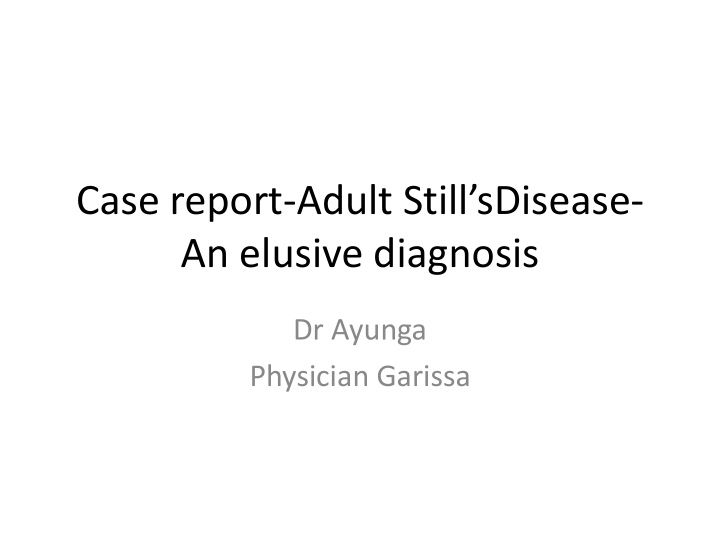



Case report- Adult Still’sDisease - An elusive diagnosis Dr Ayunga Physician Garissa
• A 23 year old gentleman of African descent • presents with a skin rash,joint pains and fever for a duration of 3 weeks. • The fever was high grade but the patient was not sick looking. • Temperature ranged from 38-40 degrees celsius. • He had generalized joint pains but had no joint effusions.
• The patient had evanescent salmon-colored nonpruritic rash that was mainly on the chest and abdomen. • A full hemogram revealed a white blood cell count of 27x10 9 with 90% being neutrophils. • A blood culture was negative . • A bone marrow aspirate and peripheral blood film excluded leukemia as it reported a normal marrow. • Anti-Cyclic citrullinated antibodies (Anti-ccp) were negative at 2.0 EU/ml (0-10).
Treatments • Patient was initially treated for septicemia with strong antibiotics despite a negative blood culture but without improvement. • Patient was then sent for a consultation in which Adult Still’s disease was suspected because of the spiking fevers, elevated WBCC ,the rash on the trunk and the arthritis. • The patient was put on high-dose aspirin at 900mg 1 g tid,hydroxychloquine 200mg bd and prednisone at 15 mg tid. • The patient responded quite well but the condition has been recurrent on stopping the treatment.
Discussion • ADULT STILL'S DISEASE • Still's disease is considered a variant of rheumatoid arthritis in which high spiking fevers are much more prominent, especially at the outset, than arthritis. • This syndrome also occurs in adults. • Most adults are in their 20s or 30s; onset after age 60 is rare. • The fever is dramatic, often spiking to 40°C, associated with sweats and chills, and then plunging to several degrees below normal.
• Many patients initially complain of sore throat. • An evanescent salmon-colored nonpruritic rash, chiefly on the chest and abdomen, is a characteristic feature. • However, the rash can easily be missed since it often appears only with the fever spike. • Many patients also have lymphadenopathy and pericardial effusions. • Joint symptoms are mild or absent in the beginning, but a destructive arthritis, especially of the wrists, may develop months later.
• Anemia and leukocytosis, with WBCC exceeding 40,000/mcL, are the rule. • Ferritin levels are often exceptionally high in adult Still's disease — for reasons that are not clear. • The diagnosis requires exclusion of other causes of fever. • The diagnosis of adult Still's disease is strongly suggested by the fever pattern, sore throat, and the classic rash. •
• 50% of the pts respond to high-dose aspirin or other NSAIDs • 50% require prednisone, sometimes in doses greater than 60 mg/d. • TNF inhibitors may be helpful for some pts with refractory adult Still's disease, but most patients treated with these agents achieve only partial remissions. • About one-third of pts have recurrent episodes.
Recommend
More recommend